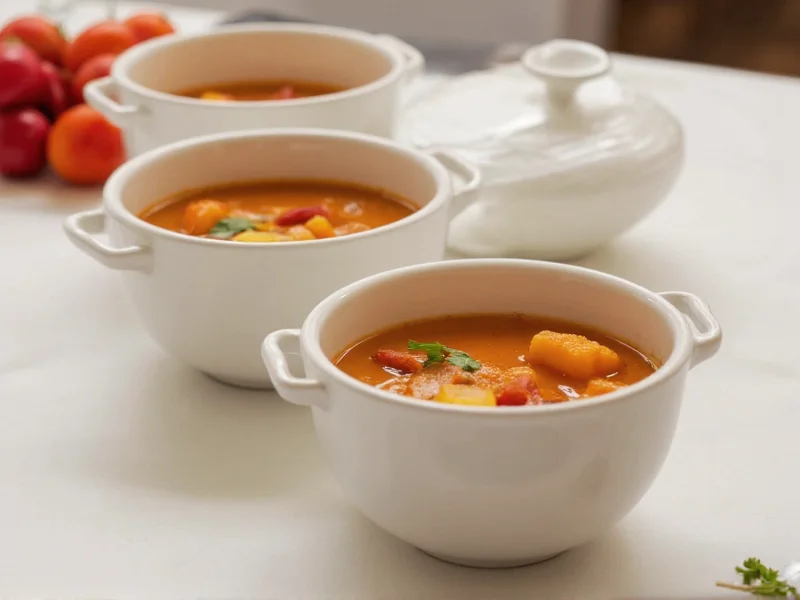Soup bowls with handles represent a practical evolution in tableware design, addressing a fundamental challenge of traditional soup bowls: handling hot liquids safely. These specialized bowls incorporate one or two sturdy handles that allow users to comfortably grip the vessel without risking burns from hot ceramic or stoneware surfaces. The ergonomic design provides better control when serving, transporting, and eating soup, particularly when temperatures exceed safe handling thresholds for bare hands.
Why Handles Make Soup Bowls More Functional
The primary advantage of soup bowls with handles lies in thermal management. When soup reaches serving temperature (typically 165°F/74°C or higher), the bowl itself becomes too hot to handle comfortably without protection. Handles create a thermal barrier between the user's hands and the heated bowl material. This design feature serves multiple practical purposes:
- Prevents accidental spills caused by instinctive dropping of hot containers
- Enables comfortable consumption of piping hot soups without waiting for cooling
- Provides better control when serving from large pots or tureens
- Offers improved stability for individuals with limited hand strength or dexterity
Common Materials for Handle-Equipped Soup Bowls
The material composition significantly impacts both functionality and durability. Below is a comparison of popular options for soup bowls with handles:
| Material | Heat Retention | Durability | Dishwasher Safe | Best For |
|---|---|---|---|---|
| Stoneware | Excellent | High | Generally yes | Daily use, oven-to-table service |
| Ceramic | Good | Moderate | Varies | Decorative settings, moderate heat |
| Porcelain | Moderate | Low-Moderate | Generally yes | Formal dining, delicate soups |
| Bone China | Poor | Low | Hand wash recommended | Special occasions, cool soups |
| Tempered Glass | Poor | Moderate | Generally yes | Cold soups, microwave use |
When selecting microwave safe soup bowls with handles, stoneware and tempered glass options typically perform best. For those seeking best soup bowls with handles for hot soup in restaurant settings, commercial-grade stoneware provides optimal heat retention while maintaining structural integrity through repeated heating and cooling cycles.
Ergonomic Design Considerations
The effectiveness of soup bowl handles depends significantly on their design and placement. Optimal handle configuration follows ergonomic principles that accommodate natural hand positioning:
- Single-handle design: Typically positioned opposite the spoon rest area, allowing thumb placement on the rim for added stability
- Dual-handle configuration: Provides balanced grip points, particularly beneficial for larger capacity bowls (16+ oz)
- Handle curvature: Should follow the natural arc of fingers when grasping
- Thermal insulation: Wider handles (1-1.5 inches) provide better heat separation than thin designs
For individuals with arthritis or limited hand mobility, soup bowls with handles for elderly users often feature oversized, contoured grips with non-slip textures. These adaptations make independent soup consumption more accessible without compromising traditional aesthetics.
Sizing and Capacity Guidelines
Soup bowl dimensions directly impact both functionality and dining experience. Standard measurements for handle-equipped bowls include:
- Appetizer portions: 8-10 oz capacity, 5-6 inch diameter, ideal for bisques and consommés
- Main course soups: 12-16 oz capacity, 7-8 inch diameter, suitable for chowders and stews
- Family-style serving: 24+ oz capacity, 9-10 inch diameter, often with dual handles for stability
When shopping for ceramic soup bowls with handles, consider both the bowl's interior volume and the external dimensions. Handles add approximately 1-2 inches to the overall width, which affects storage compatibility in standard cabinet spaces.
Care and Maintenance Best Practices
Proper care extends the lifespan of handle-equipped soup bowls while maintaining their functional integrity. Key maintenance considerations include:
- Temperature transitions: Avoid placing hot bowls on cold surfaces or vice versa to prevent thermal shock
- Cleaning methods: While many are dishwasher safe soup bowls with handles, hand washing preserves glaze integrity longer
- Storage techniques: Stack bowls with protective padding between layers to prevent handle damage
- Microwave usage: Remove any metallic accents before heating, even on microwave safe soup bowls with handles
For commercial kitchens using soup bowls with handles for restaurants, implementing a standardized handling protocol reduces breakage rates by up to 40%. This includes designated drying racks that support the bowl base rather than hanging by handles.
Specialized Applications and Use Cases
Certain environments benefit significantly from handle-equipped soup bowls due to specific operational requirements:
- Educational settings: Child-safe designs with smaller handles accommodate developing motor skills
- Healthcare facilities: Textured handles provide better grip for patients with tremors or weakness
- Outdoor dining: Insulated double-wall designs maintain temperature while keeping handles cool
- Professional kitchens: Standardized shapes ensure consistent portioning and stacking efficiency
For camping enthusiasts, lightweight titanium soup bowls with handles for camping offer durability and heat resistance without adding significant weight to backpacking gear. These specialized versions often feature folding handles to maximize portability.
Selecting the Right Soup Bowl with Handles
When choosing between various options, consider these five critical factors:
- Intended use frequency: Daily use warrants more durable materials than occasional entertaining
- Temperature requirements: High-heat applications need thermal shock-resistant materials
- Ergonomic compatibility: Test handle shape with your natural grip pattern
- Storage constraints: Measure cabinet space considering the added width from handles
- Cleaning requirements: Verify compatibility with your preferred cleaning method
For families with children, soup bowls with handles for kids often feature smaller proportions and brighter colors to encourage independent eating. These typically have thicker walls for durability and rounded handle edges for safety.
Conclusion: The Functional Advantage of Handles
Soup bowls with handles solve a fundamental problem in hot liquid consumption through thoughtful design integration. By providing secure grip points that remain cool while the bowl contents stay hot, they enhance both safety and dining enjoyment. Whether for home use, professional food service, or specialized applications, the right handle-equipped soup bowl improves the entire soup experience through better temperature management and ergonomic handling. When selecting ergonomic soup bowls with handles, prioritize material quality, handle design, and proper sizing to ensure optimal functionality for your specific needs.











 浙公网安备
33010002000092号
浙公网安备
33010002000092号 浙B2-20120091-4
浙B2-20120091-4